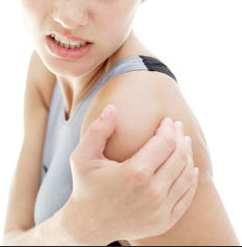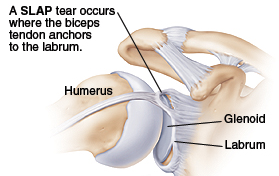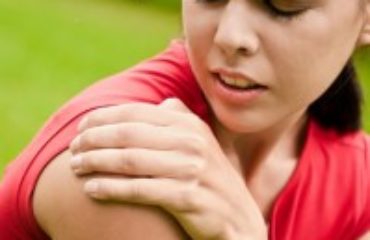A superior labrum anterior and posterior (SLAP) tear is an injury to the labrum, which is a cartilage ring that surrounds the shoulder joint socket. The shoulder is made of three bones: the humerus (upper arm bone), the scapula (shoulder blade), and the clavicle (collarbone). The head of the humerus fits into a round socket near the scapula, which is called the glenoid. 
The labrum surrounds the outer edge of the glenoid, and it helps to stabilize the shoulder joint. In a SLAP injury, the top portion of the labrum is torn along with the upper area of the biceps tendon. These injuries are usually caused by repetitive shoulder motion or acute trauma, such as a fall onto an outstretched arm or a motor vehicle accident.
Decision for Surgery
To determine how a labral tear should be treated, the Phoenix sports medicine doctor will take a detailed medical history regarding the injury. He/she will inquire to the specific activity that caused the injury, what shoulder problems the patient has, and what type of activities the patient does. A physical examination is done to assess shoulder strength, range of motion, and stability. Depending on these findings. The doctor will take x-rays and a magnetic resonance imaging (MRI) to show the labrum tear. After considering all of these findings, the decision for surgery will be made.
Nonsurgical treatment is only considered for certain SLAP injuries. Patients who are not candidates for surgical repair include the elderly, frail people, and inactive patients. Conservative measures include non-steroidal anti-inflammatory medications and physical therapy.
Surgical Treatment
Most SLAP injuries require surgical repair. The repair options include:
- Arthroscopy – This surgical procedure is most common for the repair of SLAP i
 njuries. During the surgery, the Phoenix orthopedic doctor inserts a small camera on a flexible tube (called an arthroscope) into the shoulder joint through a tiny incision. This allows for picture viewing on a TV monitor. The Scottsdale orthopedic surgeon makes other small incisions to insert surgical instruments inside the joint for repair purposes. The repair may require removal of the torn portion of the labrum, or reattachment of the tear using stitches. Once the labral tear is repaired, the incisions are closed with sutures.
njuries. During the surgery, the Phoenix orthopedic doctor inserts a small camera on a flexible tube (called an arthroscope) into the shoulder joint through a tiny incision. This allows for picture viewing on a TV monitor. The Scottsdale orthopedic surgeon makes other small incisions to insert surgical instruments inside the joint for repair purposes. The repair may require removal of the torn portion of the labrum, or reattachment of the tear using stitches. Once the labral tear is repaired, the incisions are closed with sutures. - Open surgery – With this surgery, the sports medicine doctor makes larger incisions around the shoulder joint to repair the torn labrum and biceps tendon. The SLAP tear is usually debrided, where the torn portion of the labrum is shaved away. Anchor sutures are used to attach the torn labrum to the bone. After the repair, the doctor closes the incisions and applies an immobilizer brace.
Complications and Rehabilitation
Following a labral tear repair surgery, complications are rare. These include bleeding, infection, shoulder stiffness, and damage to the blood vessels and/or nerves. The outcome of the surgery  depends on the patient’s health, the type of injury, and the surgeon’s expertise. The majority of patients regain full strength and mobility following a SLAP repair.
depends on the patient’s health, the type of injury, and the surgeon’s expertise. The majority of patients regain full strength and mobility following a SLAP repair.
After the procedure, the repair is protected while the labrum heals. The patient’s arm is kept from moving in a sling for up to 4 weeks following the procedure. The doctor orders a physical therapy program, which focuses on flexibility and strengthening. Return to sports and work activities is allowed 3 to 4 months after the surgery.


